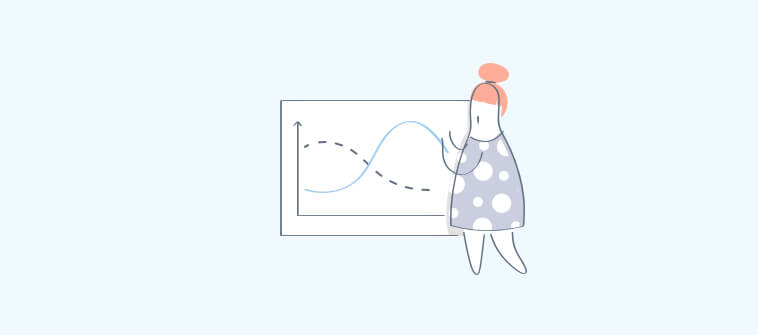Are you tired of chaotic project workflows, missed deadlines, and frustrated team members? Kanban project management might be the solution you’re looking for!
The Kanban approach emphasizes limiting work in progress while promoting continuous improvement.
Using a Kanban board, team members can visualize the status of their work and identify roadblocks instantly. The increased visibility into every task and workflow takes the guesswork off the table.
In this blog, we will learn what Kanban project management is, its benefits, and its principles. We will also explore how to use the Kanban board for increased productivity and smooth project execution.
What Is Kanban Project Management?
The Kanban project management approach uses a Kanban board to visually represent work and progress.
The board consists of columns and cards. The columns represent the workflows of the project, such as “To-do,” “In Progress,” and “Done.” These columns consist of cards that represent the tasks of a project.
The distribution of task cards in the workflow columns helps you organize your project tasks across the board for smooth project execution.
The task cards display everything related to the task, such as task name, due dates, assignees, file attachments, tags, and conversations.
Overall, Kanban board project management allows teams to easily see what needs to be done, what is in progress, and what has been completed. This also allows you to limit work in progress, enabling a more efficient and streamlined workflow, resulting in improved productivity and better quality work.
So effective Kanban project management helps you:
- Visualize task progress across different workflows
- Limit work in progress
- Improve team collaboration and efficiency
If you want to know more about a Kanban board, watch this video:
Benefits of Kanban for Project Management
Kanban project management provides numerous benefits that can help teams improve their workflow and increase efficiency.
Its most significant benefits include:
1. Improved Organizational Skills
One of the key benefits is that Kanban provides a visual representation of work, allowing team members to easily see what needs to be done, what is in progress, and what has been completed. This provides a clear project overview that helps team members prioritize their work effectively.
Read More: A Quick Guide: How to Prioritize Tasks
2. Limit Work in Progress
Another benefit of Kanban is that it promotes a limit on work in progress. This way, teams can focus on completing tasks timely and avoid work overload. This promotes a more efficient workflow and ensures that each task is given the necessary attention to provide high-quality work.
3. Identify Bottlenecks Timely
Kanban also helps teams to identify and remove bottlenecks in the workflow. With clear workflow visualization, teams can easily identify areas where work is piling up and take steps to address these issues. This helps to keep the workflow moving smoothly and ensures that tasks are completed on time.
4. Offers Flexibility for Managing Projects
Kanban provides a flexible approach to project management that you can adapt to the needs of different teams and projects. This allows teams to tailor their approach to suit their specific needs, ensuring they deliver the best possible results within the defined timeline.
When to Use a Kanban Tool?
Kanban tools can be a powerful way to improve your team’s workflow, but knowing when to use them is crucial.
If you are sure your project’s scope will remain the same, Kanban is the approach to use. You can add all project tasks to the board and track them moving forward from one workflow to the next.
Kanban tools are particularly useful for teams with a lot of work in progress at any given time. By limiting work in progress and visualizing the flow of work, Kanban can help teams prioritize their work and identify bottlenecks in the process. This can lead to a more efficient and streamlined workflow, reducing waste and increasing productivity.
Also, if your tasks don’t have too many dependencies and projects don’t require continuous improvement, Kanban will work well for you.
Read More: A Comprehensive Guide on Task Dependencies in Project Management
However, Kanban is not a silver-bullet solution for all project and team management issues.
If your team’s work is highly repetitive, predictable, and low-variation, using Kanban for project management might not be the best fit.
Also, Kanban is not suited for complex projects or projects that require a lot of planning and coordination.
Overall, Kanban tools can be a powerful way to improve your team’s workflow, but it’s important to carefully consider whether it fits your specific needs and situation.
The Core Principles of Kanban Project Management
Kanban project management is based on several core principles that are designed to improve workflow and increase efficiency.
Let’s see what these core principles are.
1. Principle #1: Visualize Work
The foundation of Kanban project management is visualizing work. This involves creating a visual representation of the work that needs to be done.
Each task or work item is represented by a card that is placed in the appropriate column, indicating its current status. By visualizing work in this way, team members can easily see what needs to be done, what is in progress, and what has been completed. This promotes transparency and collaboration, as everyone can see the progress of the project and identify any bottlenecks or issues that need to be addressed.
2. Principle #2: Limit Work in Progress
One of the fundamental principles of Kanban is limiting the amount of work in progress (WIP). This means the team should only work on a set number of tasks at any given time, based on their capacity to deliver high-quality work.
By limiting WIP, the team can avoid overload and reduce the risk of delays or mistakes due to multitasking. As a result, the team can maintain a steady workflow, deliver work on time, and continuously improve their process.
3. Principle #3: Accept Incremental Changes
In Kanban, instead of making big changes that can cause uncertainty and resistance, the team should focus on making small, continuous improvements that simplify the work process.
By making incremental changes, the team can easily adapt to new requirements or situations without disrupting the flow of work. This approach also helps to keep team members motivated, as they see the impact of their contributions and feel empowered to suggest further improvements.
4. Principle #4: Respect Current Processes, Roles & Responsibilities
Using Kanban board for project management doesn’t prohibit changes to the current process. However, you should carefully assess any modifications to ensure they don’t hamper the work process.
To respect the current processes, roles, and responsibilities, it’s crucial to evaluate the existing system and identify any aspects beneficial to ongoing projects. Any changes should be implemented gradually and with the support of the team members involved.
5. Principle #5: Foster Leadership at Every Step of Your Project
The Kanban project management methodology encourages continuous improvement. When a task is affected by unexpected changes, it’s important to let the team generate and share ideas for potential solutions.
By giving the team ownership of these tasks and involving them in implementing their ideas, you empower your team members to take on leadership roles and impact the project’s success.
Overall, these core principles provide a powerful framework for teams to manage their work and achieve their goals effectively.
Read More: How to Delegate Tasks Effectively for Leadership Success
How to Use a Kanban Board for Successful Project Management
Wondering how to use a Kanban board for project management?
Don’t worry. We’re here with a step-by-step guide to help you create a Kanban board for the best results.
In the era of digitization, we cannot continue to use a physical Kanban board, right?
That is precisely where a Kanban project management software comes in!
Let’s take the example of ProProfs Project to understand the Kanban functionality better.
Here we go!
By default, a project in ProProfs is displayed in the List view. To change, select Kanban from the View dropdown menu.

This is how a project is displayed in the Kanban view.

The Kanban board consists of workflows and cards. In the above image, “Open,” “Under Review,” “Complete,” and “On hold” represent the workflows.
The cards under each workflow represent the tasks in that specific workflow.
So by looking at this Kanban board, you can instantly grasp which task is at which stage of completion. You can also easily spot the assignees of these tasks.
With such clear information, team members can identify task requirements and fulfill them promptly.
Now, let’s decode a task card.

- The bar displays the task progress made so far.
- Click on ‘+ Add Task’ to add a new task to the workflow.
- Click on ‘+ Subtask’ to add a subtask to the task.
- By clicking on this, you can assign users or teams to that particular task card.
- Add Start and end dates to the task.
- Click on the icon to add comments and attach files.
- Use the Kebab menu to edit or delete information of a task card.
If you wish to customize and update workflows, move the workflow columns to the right or left with a simple drag-and-drop action.

You’ll notice that moving a task to another column also changes its progress percentage accordingly.

Easy, right? You can try ProProfs’ trial version to get a hands-on experience of using the Kanban board.
Drive Efficiency Using Kanban Project Management
With its simple yet powerful principles, Kanban is a valuable tool for any team looking to improve its project management practices. You can visualize work, identify bottlenecks and improve the flow of work throughout the project.
Also, with its emphasis on continuous improvement and optimizing workflow, Kanban enables teams to increase productivity and deliver high-quality work to meet the evolving demands of the marketplace.
Leveraging a good Kanban project management software like ProProfs Project can be game-changing. A software helps streamline workflows and build a single source of truth, improving team efficiency. With this, you can set up Kanban boards within minutes and track tasks as they progress from one workflow to another.
So get ready to transform the way you work using Kanban project management!
Frequently Asked Questions
Q1: Is Kanban better than scrum?
Definitely kanban is better than scrum as it helps you visualize your work and move more tasks from in-progress status easily. Kanban is also perfect for people who keep getting new tasks on priority. It helps them set the priority. Whereas scrum requires a lot of control over the scope of the project and makes it difficult for the teams to flow with the incoming tasks too.
Q2: What is the difference between a Scrum board and a Kanban board?
The Scrum board is more methodical. They require more preparation time and organization from the project manager, therefore taking up a lot of time from them and losing track of what’s more important.
The Kanban board is more about helping teams work as the work flows. They are great at making the visualization of the project clear for every member.
Q3: Does kanban have daily standups?
No they don’t actually. Kanban is about streamlining the work process and workflow for project teams. There is no standard for kanban teams to have daily standups. Also, having regular standups can be time consuming and may impact productivity at one point for team members who believe they are more productive in the morning.
Q4: Can kanban and scrum work together?
Yes, they can work together. Scrum teams can use kanban view to prioritize tasks as well and remain agile while working towards the completion of the project. What’s the best part here is that scrum teams can use both scrum and kanban views at the same time.
FREE. All Features. FOREVER!
Try our Forever FREE account with all premium features!





